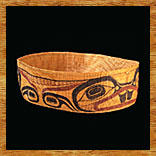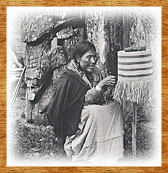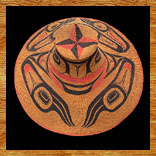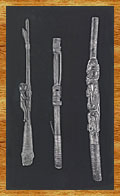
 Clothing Clothing
 Headresses Headresses
 Raven Rattles Raven Rattles
 Copper Shields Copper Shields |
Headresses (Painted Woven Hats)
Early engravings by Russian artists depict north coast chiefs wearing woven hats painted with formline crest designs at the period of first contact. Haida women made these very finely woven spruce root hats that were then painted by male artists with the crests of the commissioning family. Often, the hats had woven basketry rings added to the crown to designate high chiefs. It is claimed that each ring commemorates a potlatch feast the wearer has given, or at least the number of times the owner has been asked to dance at other feasts. Some hats from the north coast have more than twenty such rings.
Haida women excelled in basketry, particularly of spruce root, making not only woven hats but baskets and mats. Their work is different from that of Tsimshian women, who worked mostly with cedar bark strips. This distinction appears to go back at least two thousand years, to judge from the basketry recovered from Prince Rupert harbour.

 |
Shallow trays of tightly woven spruce root, such as this one with a Beaver crest, were suitable for display in a Victorian home. This one was created by Isabella and Charles Edenshaw for sale to travellers, although it is totally traditional in style and manufacture.
Collected at Masset in 1898 by Charles F. Newcombe.
CMC VII-B-1135 (S94-6777) |

Both hats and baskets were woven on a stand with a wooden form appropriate to each size and shape. Designs were either painted on or woven in. The colours of paint were restricted to red and black, with occasional touches of blue or green. For woven designs, naturally dark-coloured bark was used as a contrast, but plant fibres were also dyed brown, black, red or yellow.

 |
A woman from Masset weaving a basket on a stand, 1897. Such baskets provided women with an important source of income in the early tourist economy.
© The Field Museum, Neg. CSA854
Photographer: Edward P. Allen |

In early historic times, Haida women sold their baskets and hats to Europeans and Americans who were trading or travelling in Haida territory. Painted woven hats became a popular tourist item late in the last century, and a number of leading Haida artists of the era, such as Tom Price, John Robson and Charles Edenshaw, painted many wonderful examples. Isabella, the wife of Charles Edenshaw, was a very skilled hat weaver and, according to their daughter, Florence Edenshaw Davidson, her parents spent many winters producing painted spruce root hats, trays and baskets for sale. The hats made by the Edenshaws are distinguished by a compasslike design at the top of the crown.

 |
A woven cedar bark hat, hand painted with a Frog by Charles Edenshaw. The four-pointed star with bicoloured points is the signature of this artist.
Collected at Masset in 1911 by C. C. Perry.
CMC VII-B-899 (S92-4284) |

 |
Decorated paintbrushes with porcupine hair bristles and traces of pigment, collected from three different villages in 1905 by Charles F. Newcombe. The brush from Skidegate (left) is one of the gems of Haida miniature art; it depicts a hunter climbing a tree with his bow and arrow to shoot a bird at the top.
CMC VII-B-1022 (S92-4388)
The brush from Masset (centre) portrays a human figure with an enormous tongue that reaches to its feet. Greatly extended tongues are associated with bears, and the position of the hands pointing downward is also bearlike. The lower figure is the head of a Thunderbird.
CMC VII-B-1024 (S92-4388)
The third brush (right) from Kasaan, Alaska, is decorated with the standing figure of a Bear.
CMC VII-B-1021 (S92-4388) |

|